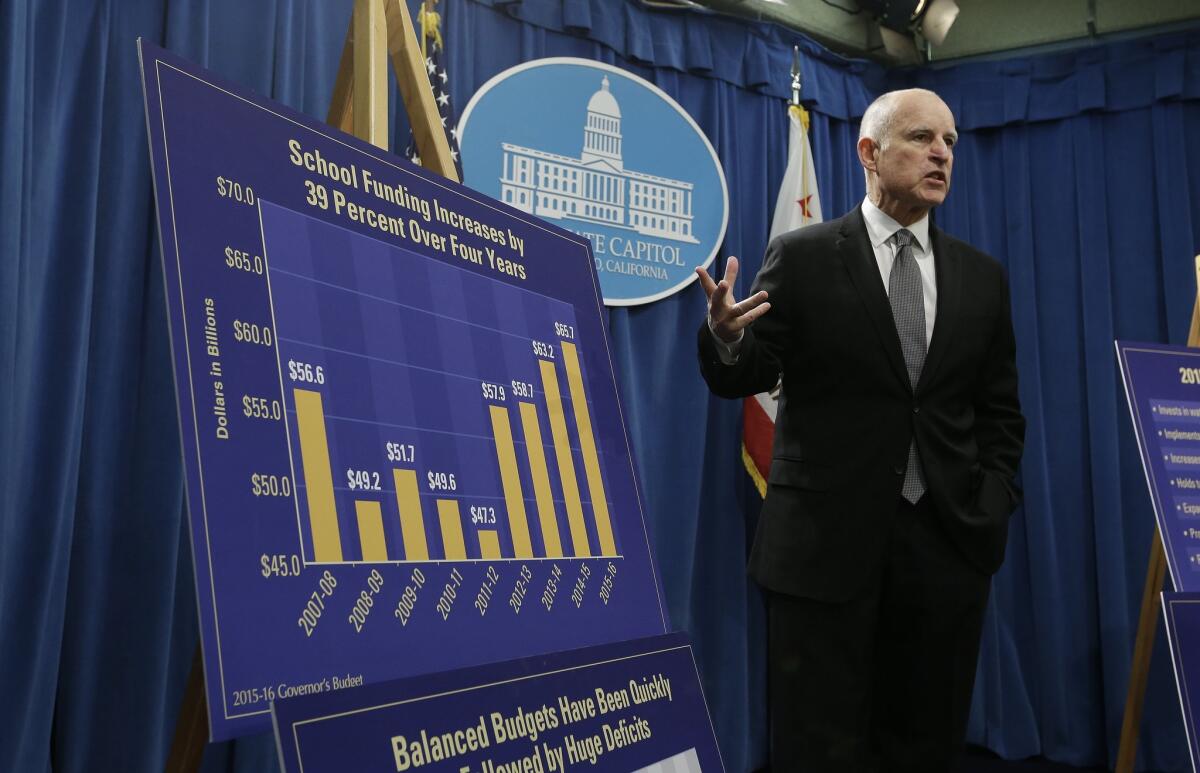Brown’s budget proposal lauded, but pressure builds for more spending

- Share via
Reporting from Sacramento — Democratic Gov. Jerry Brown cautioned against “exuberant overkill” on spending when he released his $164.7-billion budget proposal for 2015-16 on Friday, but pressure already is mounting in the Democratic-controlled Legislature to offer more state assistance to Californians struggling financially.
Sen. Mark Leno (D-San Francisco), chairman of the Senate Budget Committee, signaled that Democrats will seek to provide funding to social service programs slashed in the deficit-laden budgets passed during the recession.
“We must continue to evaluate which of our General Fund programs and services are most effective and reinvest in them wisely and in a way that benefits Californians who are in the greatest need,” Leno said.
Senate President Pro Tem Kevin de Leon (D-Los Angeles), who has proposed greater funding of higher education than Brown’s budget calls for, said the governor’s spending plan is just “the first step in his discussion with the Legislature” with the aim of helping struggling families.
“This will require better investment in education at all levels, protecting the safety net, and providing the funding to continue building the low-carbon economy of tomorrow,” De Leon said. “I look forward to debating how to best accomplish this in the most fiscally responsible way over the next six months.”
Assembly Speaker Toni Atkins (D-San Diego) said Brown’s plan provided a “solid starting point” and that she was particularly pleased by his proposal to increase education funding and bolster the state’s reserves.
She said that Assembly Democrats would continue to push for more social services spending and higher payments to doctors for Medi-Cal services, a priority of hers. Brown’s budget does not include any increases in Medi-Cal reimbursement rates.
“This is the governor’s opening salvo. Now we begin the budget dance,” Atkins said. “This is on the list. It’s going to continue to be on the list until we address it.”
Republican leaders generally praised the budget for being fiscally prudent, but said the real test comes now, when the Democratic majority in the Legislature attempts to add new spending.
“It’s a good starting place,” said Senate Republican leader Bob Huff of Diamond Bar. “The real challenge will be to hold the legislative Democrats to not building too much on it. There’s a lot of pent-up demand to grow everything.”
Huff said there were some glaring omissions from the budget. Brown said in his annual State of the State address this week that he wanted to increase the use of renewable energy and address the state’s crumbling infrastructure of roads and bridges.
“What was very deafening was what he didn’t mention,” Huff said. “In his State of the State he talked about climate change. I didn’t see anything referenced there” in the budget.
Assemblywoman Melissa Melendez (R-Lake Elsinore), the top Republican on the Assembly Budget Committee, praised the governor’s plans to address one of the state’s biggest financial problems: a $71.8-billion liability for providing healthcare to retired state workers.
However, Melendez said Brown should have done more to stimulate the economy and job growth.
“We’re a little disappointed that we didn’t hear much about jobs and the economy in there -- how we’re going to grow the economy, how we’re going to create the environment to make jobs more available to Californians,” she said.
The governor’s proposal will kick start negotiations with lawmakers and advocates over the next several months. A final budget is due in June, and the next fiscal year begins on July 1.
More to Read
Sign up for Essential California
The most important California stories and recommendations in your inbox every morning.
You may occasionally receive promotional content from the Los Angeles Times.















